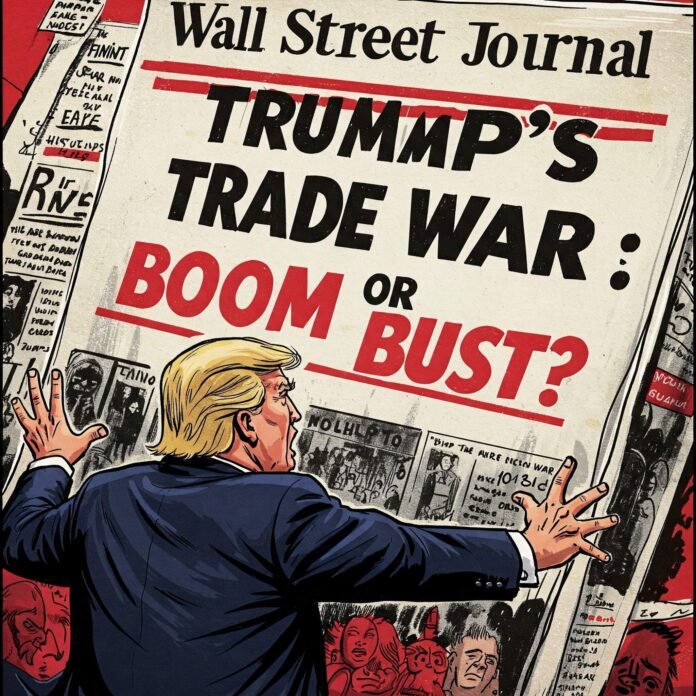The Trump Wall Street Journal coverage has been making waves, with headlines dissecting everything from tariffs to foreign policy. But what’s really going on behind the scenes? While the Wall Street Journal (WSJ) is a trusted name in journalism, its reporting on Trump’s second term reveals layers of complexity that mainstream media often glosses over. In this post, we’ll dive into the latest WSJ coverage, uncover what’s being left unsaid, and arm you with tools to navigate the noise. Let’s cut through the spin and get to the truth.
Why the Trump Wall Street Journal Coverage Matters
The WSJ has a reputation for rigorous reporting, but its Trump Wall Street Journal coverage isn’t just about facts—it’s about framing. Since Trump’s re-election, the WSJ has published critical editorials and in-depth pieces on his policies, from trade wars to media disputes. For example, a recent WSJ editorial warned that Trump’s tariff policies could lead to a “heavy political price” if they backfire, especially on issues like Ukraine.
Why does this matter? The WSJ’s influence shapes how investors, policymakers, and the public perceive Trump’s administration. Its editorials don’t just report—they set the tone for Wall Street and beyond.
Key Takeaways from Recent WSJ Coverage
- Tariffs and Trade Wars: The WSJ has extensively covered Trump’s tariff battles, noting their impact on markets and consumer prices.
- Media Criticism: Trump has publicly called out the WSJ, urging Rupert Murdoch to “make changes” due to negative coverage.
- Global Implications: From Ukraine to China, the WSJ frames Trump’s foreign policy as chaotic but potentially strategic.
What’s Driving the WSJ’s Trump Coverage?

The Trump Wall Street Journal coverage isn’t happening in a vacuum. Several factors shape how the WSJ approaches Trump’s administration:
Editorial Stance
The WSJ’s editorial board leans conservative but has been critical of Trump’s unpredictability. For instance, they’ve called his tariff policies a “mistake” that could tank markets, a stance that’s drawn Trump’s ire. This tension reveals a rift between traditional conservatism and Trump’s populist approach.
Economic Focus
As a business-focused outlet, the WSJ prioritizes how Trump’s policies affect markets. Their reporting on tariffs, for example, highlights warnings from companies like Walmart about price hikes and shortages. This angle appeals to their audience of investors and executives.
Public Backlash
The WSJ doesn’t just report—it responds to feedback. Trump’s base, which often distrusts mainstream media, has pushed back against negative coverage, prompting the WSJ to balance criticism with broader context.
The Bigger Picture: Media Bias and Public Perception

The Trump Wall Street Journal coverage is part of a larger media ecosystem. According to Pew Research, 62% of Americans believe news organizations favor one political party, which fuels distrust in outlets like the WSJ. Pew Research Center. Here’s how the WSJ fits into this landscape:
Comparing WSJ to Other Outlets
- The New York Times: Often more critical of Trump, focusing on social and political controversies.
- Fox News: Tends to align with Trump’s base, downplaying negative stories.
- WSJ’s Niche: Balances business implications with political analysis, appealing to a centrist-conservative audience.
The Role of the “MAGA Echo Chamber”
The WSJ has called out the “MAGA media echo chamber” for amplifying Trump’s narrative, but they’re not immune to criticism themselves. Their editorials sometimes reflect Wall Street’s priorities over Main Street’s concerns, which can alienate readers.
What the Media Isn’t Telling You About Trump’s Coverage
The Trump Wall Street Journal coverage leaves gaps that savvy readers need to fill. Here are three underreported angles:
- Trump’s Strategic Media Play: Trump’s attacks on the WSJ aren’t random—they’re designed to rally his base and undermine critical outlets. By calling out Murdoch, he shifts focus from policy failures to media bias.
- Economic Nuance: While the WSJ emphasizes tariff risks, they downplay potential long-term benefits, like job creation, which Trump’s supporters prioritize.
- Global Context: The WSJ’s focus on U.S. markets sometimes overshadows how Trump’s policies affect allies like Japan or South Korea, which face their own tariff pressures.
What Readers Can Do to Stay Informed

Navigating the Trump Wall Street Journal coverage requires critical thinking. Here’s how to stay ahead:
- Diversify Your Sources: Cross-reference WSJ articles with outlets like The New York Times or Axios for a fuller picture. The New York Times
- Check Primary Sources: Trump’s Truth Social posts often reveal his unfiltered perspective, bypassing media spin.
- Follow the Money: Understand how WSJ’s business focus shapes its lens—look at market data from Bloomberg to contextualize their claims. [ attualmente non disponibile per Bloomberg]
- Engage Critically: Question editorials and seek out reader comments on platforms like X to gauge public sentiment.
Conclusion
The Trump Wall Street Journal coverage is more than just headlines—it’s a window into the tensions between media, politics, and public perception. By understanding the WSJ’s motivations, comparing their reporting to other outlets, and filling in the gaps, you can form a clearer picture of Trump’s second term. Stay curious, cross-check sources, and don’t let the spin dictate your perspective.
What’s your take on the WSJ’s Trump coverage? Drop a comment below or share this post to spark a conversation!





























